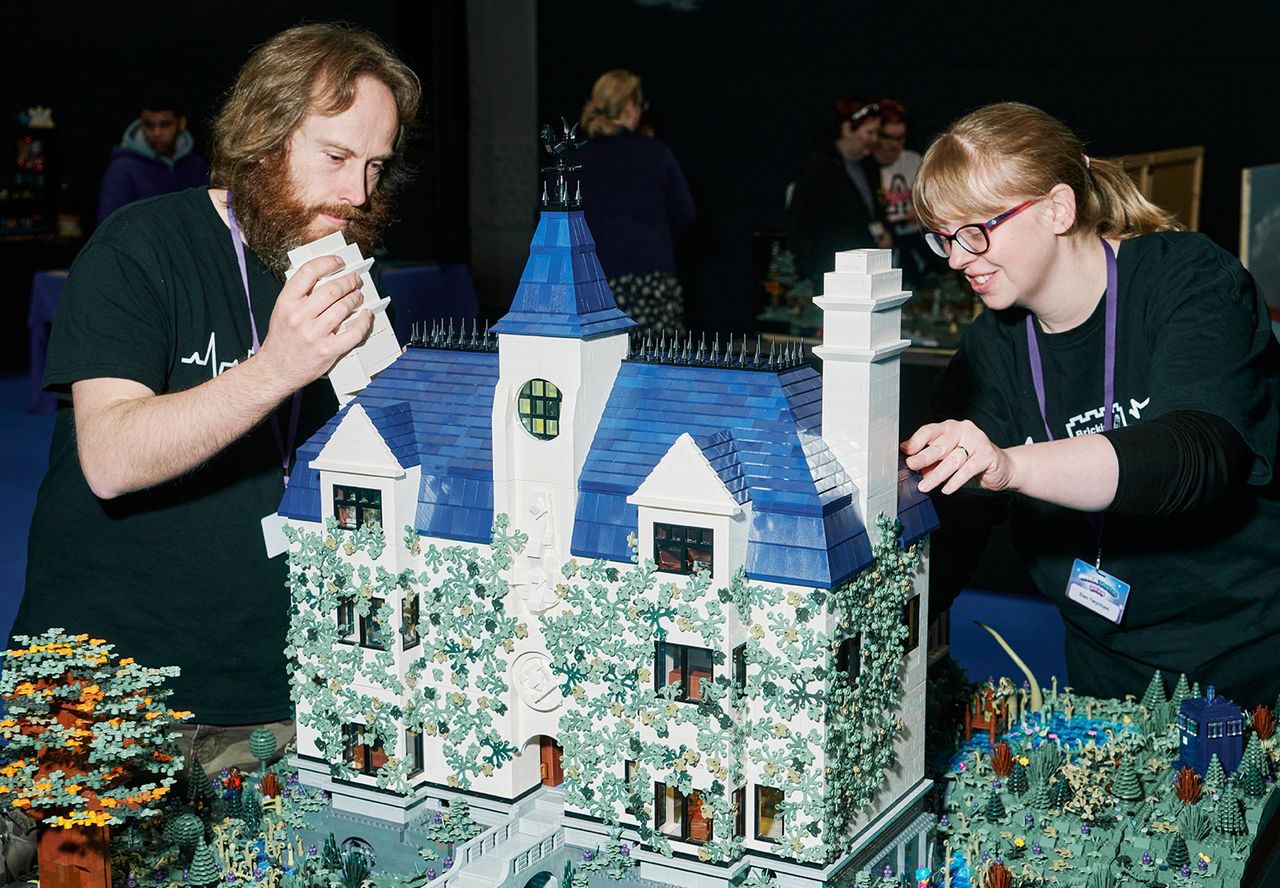MANCHESTER, England—Lego has always been a toy for children, but try telling that to its legion of adult fans.
Grown-up builders, often rediscovering Lego after what aficionados refer to as the “dark age”—the void separating childhood fandom and its resumption as an adult—are increasingly helping cement the Danish company’s status as the world’s biggest toy maker by sales.
“We don’t buy every new set that comes out,” said Jonny Edmondson, a 38-year-old graphic designer at a mass gathering of Lego enthusiasts in Manchester in February. “We’ve got to eat.”
Lego has doubled the size of its range targeting people over the age of 18 since it launched in 2020, and has made a series of ads aimed at older builders with the slogan “Adults Welcome.” The best part from the company’s perspective? Adults will pay grown-up prices that kids could only dream of.
Think $850 Millennium Falcons and $680 Titanics.
When Lego first developed its plastic bricks in the 1950s, it had little clue that its colorful spaceships, racing cars and castles would ever appeal to anyone besides children.
Over time it noticed that many former child fans carried their love of Lego into adulthood, becoming what the company calls AFOLs, or adult fans of Lego, while other grown-ups were drawn in by collaborations with franchises such as Star Wars. Eventually the company realized that adults were a potentially lucrative audience in their own right, prompting a shift in strategy.
“We decided to focus on adults because we realized that we had a much bigger opportunity than we were tapping into,” said Julia Goldin , Lego’s chief product and marketing officer.
Lego already produced some grown-up sets, but they weren’t easy to identify. That changed in 2020 when it launched a new 18+ category, comprising elaborate and often pricey sets in serious-looking black boxes. The 18+ sets include the Lego Icons range. Among its “advanced builds designed with adult fans in mind” are a $200 Concorde replica with 2,083 pieces and a 6,167-piece, $500 depiction of Rivendell, the Elvish town from “The Lord of the Rings.”
For many adults, buying Lego had previously triggered “a kind of embarrassment—they would go into a store and have an imaginary nephew or niece they’d buy for,” said Genevieve Capa Cruz, Lego’s head of adult products. The new packaging, which set the 18+ products apart from boxes meant for kids with its grown-up appearance, helped overcome that obstacle, she said.
The timing couldn’t have been better. The 18+ line landed just as millions of people, trapped at home by Covid-19 lockdowns, were looking for a hobby to alleviate the boredom. Sales of adult sets boomed.
By 2021 grown-ups buying for themselves constituted a fifth of Lego’s sales, up from 5% five years earlier, Tormod Askildsen, then Lego’s head of AFOL engagement, said at the time. Lego declined to disclose current sales figures but said sales of adult sets had continued to grow since the pandemic, and that it plans to further expand the range.
Lego has 142 sets designed for grown-ups, out of 926 sets currently available on its U.S. website. Of the 42 Lego sets now on sale that cost $300 or more, all but two are for adults.
Sales to adults have helped drive up Lego’s revenue, which has more than doubled over the past decade to hit $9.7 billion last year. Lego Icons was one of its star properties in 2023, the company said last month.
Lego’s growth did slow last year, though, with sales rising 2%—its weakest performance in years—amid a slump in global toy sales. That makes its adult customers even more valuable, while raising pressure on the company to keep the free-spending grown-up cohort engaged.
The toy’s popularity among adults has been aided by reality-TV show “Lego Masters,” a Lego-backed series in which contestants tackle building challenges, and 2014’s “The Lego Movie.” Both have helped normalize Lego as an activity for grown-ups.
“Nowadays it’s not so geeky,” said adult fan Sian Twynham, who got into Lego while she was on maternity leave from her job as a pharmacist in the central English town of Market Harborough. “You can have a set on your coffee table and no one would bat an eyelid.” Her daughter, now eight, has also become a Lego nut.
Movie tie-ups are popular with older builders. Besides Star Wars and Marvel sets, the adult Lego lineup includes the DeLorean from “Back to the Future,” the white Cadillac from “Ghostbusters” and the Ornithopter from “Dune.”
Adults also gravitate toward art, architecture, nature and nostalgia, said Capa Cruz. Lego recently added working replicas of an old Pac-Man arcade game and a Polaroid camera to its 18+ range, for example, alongside a 2,316-brick rendition of Van Gogh’s painting “The Starry Night” and a $160 replica of Japan’s Himeji Castle.
“When it comes to adults it’s also about the displayability: It needs to look good on your shelf,” Capa Cruz said.
The cost gives some customers pause; they ask, “Should I buy this [$650] Star Wars Venator for myself?” said Capa Cruz. But as adult Lego becomes more widely accepted, more customers view it as a treat—akin to splurging on new sneakers or a handbag—rather than a frivolous purchase they should feel guilty about, she said.
Lego has been surprised at the popularity of some adult sets. High demand for its range of plants and flowers, particularly among women, prompted the company to broaden its so-called “botanical collection.” The range now includes a succulents display, a wildflower bouquet and a bonsai tree.
Adult fans of Lego are also big buyers of loose bricks to make bespoke builds. Lego sells assorted bricks in stores and online through its Pick a Brick service, where thousands of individual pieces are available. It also owns the BrickLink online marketplace, which it bought in 2019 to “strengthen its connection” with its adult fan base.
At Bricktastic, the U.K.’s largest Lego show, held in the northern English city of Manchester, some of the country’s most ardent adult Lego fans exhibited creations they’d been laboring over for months, if not years. Lego isn’t affiliated with the event.
A Vietnam War tableau, a recreation of the doomed space colony from the movie “Aliens” and wearable Viking armor were among the builds on display.
Edmondson, the graphic designer, moved from Sacramento, Calif., to Edinburgh last year to join his Scottish fiancée, Catherine Rankin, a structural engineer, after they met through the online Lego community. Together they worked for 14 days straight creating a medieval castle for the Bricktastic show.
The couple have freelance day jobs that enable them to focus entirely on Lego for long stretches when the mood takes them. They spend about $250 a month growing their Lego stockpile, they said.
Four years ago Darren Hallbury, an ambulance technician, was struggling to think of something to buy his husband, Mark, for Christmas when he spotted a fairy-tale Gingerbread House set in the window of his local Lego store in Birmingham. “I just thought it was something different,” he said. “It snowballed from there.”
The novelty gift developed into an all-consuming passion, to the point where the Hallburys, like other committed AFOLs, now travel to Lego exhibitions to display their creations. Their latest construction was a sprawling replica of Jurassic Park depicting dinosaurs rampaging across a finely detailed jungle landscape. They spent 19 months building it in their garage.
“This is a side project,” said Simon Pickard, introducing Outpost 6987, a 300,000-brick Martian spaceport that took him, together with his father David and his son Jeremiah, nine years and some $40,000 to build. (AFOLs are often deeply immersed in Lego history: 6,987 was the box number of a Lego Blacktron set from the 1980s to which the Pickards’ creation pays homage.)
Lacking space at home, they worked in their local church. Pickard’s real passion is historical scenes, such as his Battle of Thermopylae, which turned heads in Lego circles several years ago, he said.
Pickard welcomed Lego’s newfound respectability as a grown-up hobby, but said its popularity had complicated life.
“Everything is now harder to get and it’s more expensive,” he said. “People used to just give me bin bags full of old Lego, now they want to know how much it’s worth.”
Write to Trefor Moss at Trefor.Moss@wsj.com



